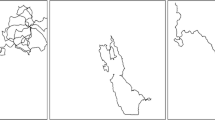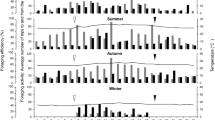Summary
When prey of two sizes (6 and 32 mg) were offered in a choice situation to foragers of the ant Formica schaufussi at different ambient temperatures, significantly more workers rejected the smaller prey at low temperatures, whereas at high temperatures workers accepted the less profitable smaller item. Foragers scavenge for arthropod prey over a temperature range of 15–40°C, and increasing temperature significantly increases a forager's oxygen consumption, an index of energy expenditure.
Similar content being viewed by others
References
Bowen RV (1982) The foraging ecology of Formica schaufussi: a test of optimal diet theory. Unpublished honors thesis, Harvard University, Cambridge, Mass
Charnov EL (1976) Optimal foraging: attack strategy of a mantid. Am Nat 110:141–151
Davidson DW (1978) Experimental tests of the optimal diet in two social insects. Behav Ecol Sociobiol 4:35–41
Holm-Jensen I, Jensen TF, Nielsen MG (1980) The influence of temperature upon the rate of CO2 production in influrane anaesthetized worker ants of Formica rufa L. Insectes Soc 27:180–185
Krebs JR (1978) Optimal foraging: decision rules for predators, chap 2. In: Krebs JR, Davies NB (eds) Behavioral ecology. Sinauer, Sunderland, Mass
Orians GH, Pearson NE (1979) On the theory of central place foraging, chap 6. In: Horn DJ, Stairs GR, Mitchell RD (eds) Analysis of ecological systems. Ohio State University Press, Columbus, Ohio
Peakin GJ, Josens G (1978) Respiration and energy flow, chap 6. In: Brian MV (ed) Production ecology of ants and termites. Cambridge University Press, New York
Pulliam HR (1974) On the theory of optimal diets. Am Nat 108:59–74
Pyke GH, Pulliam HR, Charnov EL (1977) Optimal foraging: a selective review of theory and tests. Q Rev Biol 52:137–154
Rissing SW (1982) Foraging velocity of seed-harvester ants Veromessor pergandei (Hymenoptera: Formicidae). Environ Entomol 11:905–907
Schoener TW (1971) Theory of feeding strategies. Annu Rev Ecol Syst 2:369–404
Schoener TW (1979) Generality of the size-distance relation in models of optimal feeding. Am Nat 114:902–914
Taylor F (1977) Foraging behavior of ants: experiments with two species of myrmecine ants. Behav Ecol Sociobiol 2:147–167
Traniello JFA (1980) Studies on the behavioral ecology of north temperate ants. Unpublished PhD thesis, Harvard University, Cambridge, Mass
Author information
Authors and Affiliations
Rights and permissions
About this article
Cite this article
Traniello, J.F.A., Fujita, M.S. & Bowen, R.V. Ant foraging behavior: ambient temperature influences prey selection. Behav Ecol Sociobiol 15, 65–68 (1984). https://doi.org/10.1007/BF00310217
Received:
Accepted:
Issue Date:
DOI: https://doi.org/10.1007/BF00310217




